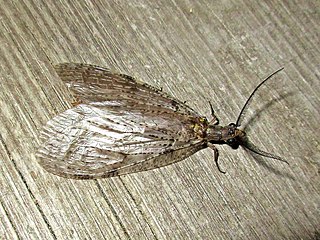
Johan Christian Fabricius was a Danish zoologist, specialising in "Insecta", which at that time included all arthropods: insects, arachnids, crustaceans and others. He was a student of Carl Linnaeus, and is considered one of the most important entomologists of the 18th century, having named nearly 10,000 species of animals, and established the basis for the modern insect classification.

Entomology, the scientific study of insects and closely related terrestrial arthropods, has been impelled by the necessity of societies to protect themselves from insect-borne diseases, crop losses to pest insects, and insect-related discomfort, as well as by people's natural curiosity. Though many significant developments in the field happened only recently, in the 19th–20th centuries, the history of entomology stretches back to prehistory.

Acheta is a genus of crickets. It most notably contains the house cricket. According to Direction 46 issued by the ICZN in 1956, this generic name is masculine in gender. Apart from the cosmoplitan house cricket, species are recorded from the Palaearctic realm and North America.
Conchaspis capensis is a species of scale insect from South Africa found on Metalasia muricata and Phylica species. It was originally described by Carl Linnaeus in his 1763 work Centuria Insectorum.

Hepatus epheliticus, known by various names, including the calico crab and Dolly Varden crab, is a species of crab. It lives in shallow water in the western Atlantic Ocean from the Chesapeake Bay to the Dominican Republic. It has a 3-inch (76 mm)–wide carapace adorned with large red spots with darker outlines.

Catopsilia scylla, the orange migrant or orange emigrant, is a species of butterfly that lives in South East Asia and Australasia. Its larvae feed predominantly on plants of the genera Cassia and Senna.

Chauliodes pectinicornis known as Summer fishfly, is a species of fishfly from North America.

Monobia quadridens, also known as the four-toothed mason wasp, is a species of solitary potter wasp found in North America. It grows to a wingspan of 18 mm (0.71 in), and feeds on small caterpillars and pollen. Two generations occur per year, with one generation overwintering as pupae.

The 10th edition of Systema Naturae is a book written by Swedish naturalist Carl Linnaeus and published in two volumes in 1758 and 1759, which marks the starting point of zoological nomenclature. In it, Linnaeus introduced binomial nomenclature for animals, something he had already done for plants in his 1753 publication of Species Plantarum.
In the 10th edition of Systema Naturae of 1758–1759, Carl Linnaeus classified the arthropods, including insects, arachnids and crustaceans, among his class "Insecta". He described the Insecta as:
A very numerous and various class consisting of small animals, breathing through lateral spiracles, armed on all sides with a bony skin, or covered with hair; furnished with many feet, and moveable antennae, which project from the head, and are the probable instruments of sensation.
In the 10th edition of Systema Naturae, Carl Linnaeus classified the arthropods, including insects, arachnids and crustaceans, among his class "Insecta". Insects with hardened wing covers were brought together under the name Coleoptera.

Entomologia Carniolica exhibens insecta Carnioliae indigena et distributa in ordines, genera, species, varietates is a taxonomic work by Giovanni Antonio Scopoli, published in Vienna in 1763. As well as describing hundreds of new species, Entomologia Carniolica contained observations on the species' biology, including the first published account of queen bees mating outside the hive.

Caryobruchus gleditsiae is a species of beetle in the family Chrysomelidae. It lives in North and Central America and develops inside the seeds of palm trees. Adults grow to a maximum length of 11 mm (0.43 in), the size depending on the size of the seed it grew up in. The species was first described by Carl Linnaeus in his 1763 Centuria Insectorum.
Omocerus bicornis is a species of tortoise beetle from South America. It lives on Cordia (Boraginaceae) plants, and is found in Brazil, Suriname, French Guiana, Suriname and Venezuela. It was first described by Carl Linnaeus in his 1763 work Centuria Insectorum under the name Cassida bicornis, and was later made the type species of the genus Omocerus by Philogène Auguste Joseph Duponchel and Alcide d'Orbigny in 1843.
Pseudophasma brachypterum is a species of stick insect found in Brazil, Suriname, Guadeloupe and Peru.

Eugaster spinulosa, a species of bush-cricket from Morocco.
Nemognatha chrysomeloides is a species of oil beetle (Meloidae) endemic to Central and South America.

Cethosia cydippe, the eastern red lacewing, is a species of butterfly from Australia, New Guinea and nearby islands. The Australian subspecies, C. c. chrysippe, is known as the red lacewing butterfly.

The 12th edition of Systema Naturae was the last edition of Systema Naturae to be overseen by its author, Carl Linnaeus. It was published by Laurentius Salvius in Holmia (Stockholm) in three volumes, with parts appearing from 1766 to 1768. It contains many species not covered in the previous edition, the 10th edition which was the starting point for zoological nomenclature.

Papilio ajaxLinnaeus, 1758 is a scientific name given in 1758 by Linnaeus to what later appeared to be a combination of three species of butterflies. The name was placed on the Official Index of Rejected and Invalid Specific Names in Zoology in 1954 after an application to that matter was submitted by Steven Corbet in 1945. The name no longer has a status as a scientific name, except in cases of homonymy; according to the rules of the International Code of Zoological Nomenclature the name Papilio ajax can no longer be given to any species.



























